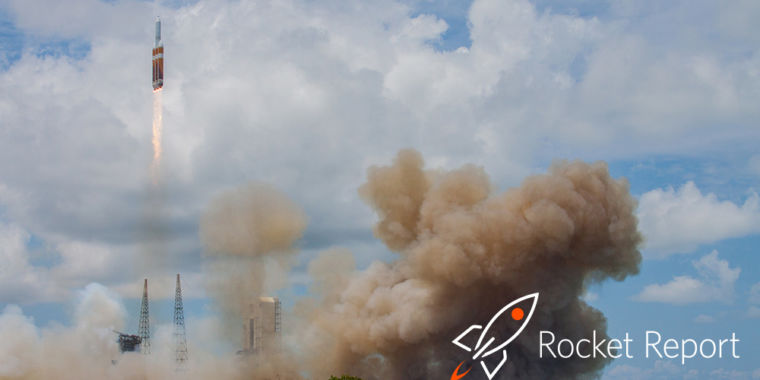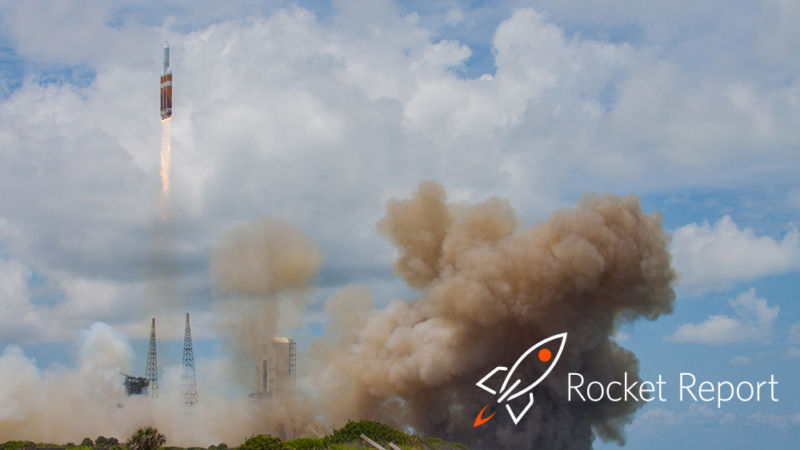
[ad_1]

Welcome to Edition 1.24 of the Rocket Report! This week we catch you up to date on efforts by Europe, Japan, and China to develop reusable rockets. (Spoiler alert: they’re a bit behind their Western competition.) We’ve also got a couple of articles about NASA’s development of the large Space Launch System. (Spoiler alert, part two: Boeing says everything is fine.)
As always, we welcome reader submissions, and if you don’t want to miss an issue, please subscribe using the box below (the form will not appear on AMP-enabled versions of the site). Each report will include information on small-, medium-, and heavy-lift rockets as well as a quick look ahead at the next three launches on the calendar.

A Chinese commercial rocket failed to reach orbit. The Chinese private company LandSpace launched its solid-fueled Zhuque-1 orbital launch vehicle on Sunday from the Jiuquan Satellite Launch Center. However, the launch failed to deploy the spacecraft in the correct orbit, NASASpaceflight.com reports. According to gbtimes, the failure was later attributed to a problematic reaction-control system.
If at first you don’t succeed … This was the first attempt by a Chinese company to put a satellite into orbit, but it won’t be the last. LandSpace and other companies such as OneSpace will soon make more attempts, with solid- and liquid-fueled rockets. The Chinese private sector has grown tremendously over the last three-plus years as the government has sanctioned its development and licensed government launch technology for its use. (submitted by Unrulycow and Ken the Bin)
Scottish spaceport may have a NIMBY problem. A campaign group called Protect The Mhoine has been set up to oppose a spaceport proposed for northern Scotland, which was to be the United Kingdom’s first satellite launch site. Opponents fear it would impact the environment, archaeology, and roads, have a potential risk to the public, and create noise, the The Press and Journal reports.
Crofters not happy … Small-scale farmers in the area, called crofters, have banded together. Crofter George Wyper, 72, said, “There is quite a split in the community and a lot of bad feeling about this. There has been no proper public consultation, and the estate board has not yet voted on the matter. It could go to the Scottish Land Court, which could take years to resolve.”
Rocket Lab sets launch date for It’s Business Time. The nine-day launch window will open from November 11 to 19, with daily launch opportunities between 03:00 to 07:00 UTC, the company said. The Electron rocket is on site at Launch Complex 1 undergoing final pre-launch checkouts, following a final successful stage-one static fire test last week.
Still adding customers … The company also added two Proxima satellites from Fleet Space Technologies to the first Electron launch, Parabolic Arc reports. These two 1.5 U CubeSats are the first of a fleet of small, low-cost satellites that will provide Internet connectivity for millions of sensor devices based in remote locations on Earth. (submitted by Ken the Bin)
Europe, Japan take steps toward reusable launcher. Aviation Week reports that the French space agency, CNES, is pressing ahead with counterparts from Germany and Japan for the development of a reusable launcher first stage. The space agencies are aiming to launch a first demonstrator test flight in Kourou, French Guiana, in 2021.
Starting from behind … The rocket is modestly sized at 15m tall and 1m in diameter. It has a reusable LOX-hydrogen engine built by Mitsubishi Heavy Industries in Japan. This Callisto project aims to eventually test its rocket up to an altitude of 50 meters and may (or may not) be a precursor to European development of a reusable rocket. The company is about a decade behind SpaceX. (submitted by DougF)
China advancing toward reusable launch, too. Chinese space-launch startup Linkspace appears close to testing a tech-demonstrator reusable rocket similar in utility to the Grasshopper rocket SpaceX used in its development of the Falcon 9 launch vehicle. There are other efforts toward reusability in China as well, gbtimes reports.
Reusing design concepts, too? … Some of the proposals look an awful lot like work done by SpaceX and Masten Space Systems. Not that we’re making any insinuations or anything. We’re pretty sure all of these efforts were conceived of and developed independently in China. Pretty sure.

Soyuz problem identified as deformed sensor. On Thursday, Russian space officials held a news conference to lay out their findings into an October 11 accident that involved the launch of a Soyuz FG rocket and its spacecraft. The problem was caused by a “bent” sensor on one of the rocket’s four boosters that failed to properly signal stage separation. This caused one of the booster stages to improperly separate from the rocket and then strike the core of the rocket.
Two in a row … Fortunately the crew escaped safely. According to the officials, the sensor rod was bent by a little more than six degrees, and this happened during assembly of the rocket. The Russian space corporation, Roscosmos, has classified this as a handling error. For those keeping score at home, the last two launches of Russian crew missions have suffered from quality-control problems that caused a pressure leak and now a rocket to fail.
China remains on pace for record-setting year. China’s previous record for orbital launches in any given year was 22, set in 2016. This year, it has already conducted 30 successful launches, and its final total by the end of the year could put China at the top of the pile in terms of global launches. That would put China above the United States and Russia for the first time, gbtimes reports.
Close to its goal … The main contractor for the Chinese space program, CASC, stated at the start of the year that it was targeting about 35 launches, with private companies possibly raising the total to close to 40 orbital missions. At the time, this seemed ambitious, but it looks like the country is going to come close, further cementing its status as a major power in spaceflight.
Europe backs its own launchers amid competition. Ministers from Germany, France, Italy, Spain, and Switzerland on Thursday signaled their “full support” for the development of the Ariane 6 and Vega-C rockets and their use as launchers for all European Space Agency missions, ABC News reports. The move was seen as a response to the Air Force rocket development awards to private American space companies.
A sensitive subject … There is a view held in Europe, Japan, and elsewhere that SpaceX and, to a lesser extent, other US companies are heavily subsidized by the US military. The idea is that their commercial success is due solely to military funding. The irony here, of course, is that SpaceX did not receive any of the Launch Service Agreement awards announced by the Air Force on October 10.
SpaceX hot-fires its crew demo Falcon 9 rocket. The company said on Twitter that it completed a static fire test on October 25 of the Falcon 9 booster that will launch SpaceX’s first demonstration mission. The test occurred at SpaceX’s rocket development facility in McGregor, Texas.
An extended test period? … Teslarati reports that this booster has spent about three months in Texas, which is about three times as long as a new Falcon 9 rocket typically spends at the test site. The longer stay is likely because this is the first Falcon 9 to use upgraded carbon-overwrapped pressure vessels required by NASA as part of the commercial crew program. (submitted by Ken the Bin)

Boeing manager defends SLS in an op-ed. In a SpaceNews op-ed that draws heavily on nostalgia, Boeing Space Launch System Project Manager John Shannon says the rocket has a bright future. “We should identify and recognize the speed bumps, roadblocks, and setbacks we encounter along the way—even the more mundane ones that don’t make it into the movies—and continue to adapt and improve our trajectory,” Shannon writes. “In that sense, I remain confident in our deep-space exploration prospects and see a bright future for SLS production and our shared journey to go where no one has gone before.”
Follows the IG report … The op-ed was written after the release of a report from NASA’s inspector general that was highly critical of the SLS program, which is significantly over budget and already running three years late. Shannon argued that many of the issues raised in that report are “from years past, no longer affect schedule or cost, and do not accurately reflect the SLS program of today.”
Another SLS official says costs are a concern. At a meeting, former astronaut and Vice President and General Manager of Propulsion for Northrop Grumman Charlie Precourt said that as the SLS rocket and Orion spacecraft move from development into operations, costs must come down. “We have to execute, but we also have to be planning for the future in terms of survivability, sustainability, and affordability,” Precourt said.
More truths … Precourt, whose company manufactures the solid rocket boosters for the SLS, made his comments at the American Astronautical Society’s Wernher von Braun Memorial Symposium in Huntsville, Alabama. “All of us need to be thinking about [how] our annual budget for this will not be what it is in development,” he said. “That’s a very serious problem that we have to look forward to and to try to rectify so that we are sustainable.”
Next three launches
Nov. 3: Soyuz 2.1b | Glonass-M satellite | Plesetsk Cosmodrome, Russia | TBD
Nov. 3: Pegasus XL | NASA’s ICON satellite | Air launch from Florida | 08:00:00 UTC
Nov. 7: Soyuz ST-B | MetOp-C satellite | Kourou, French Guiana | 00:47 UTC

[ad_2]
Source link